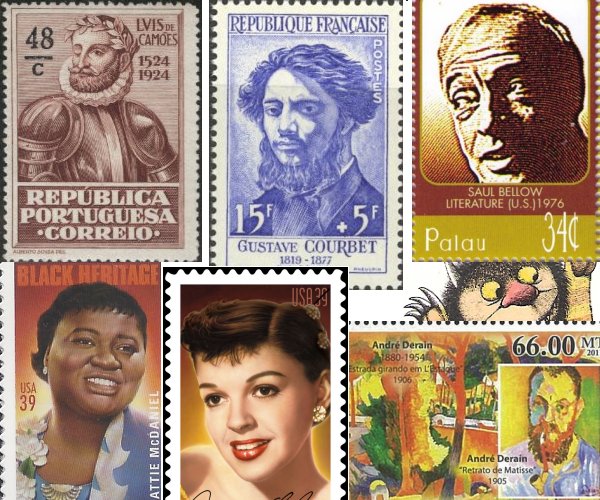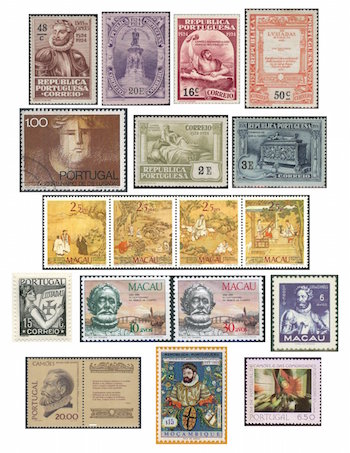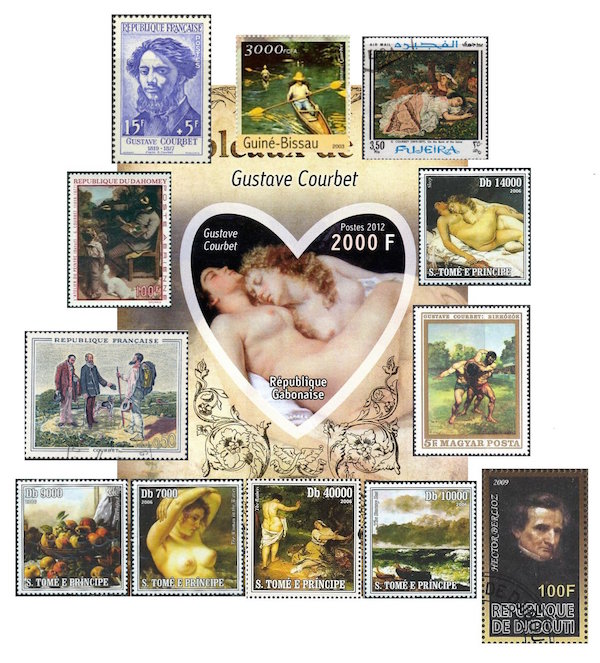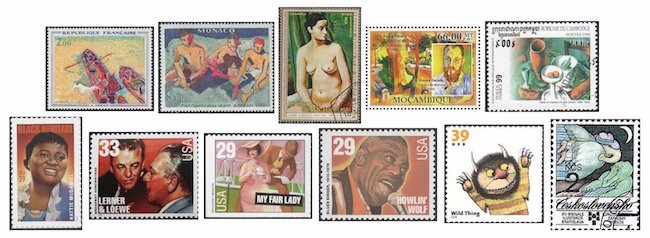The Arts on the Stamps of the World — June 10
An Arts Fuse regular feature: the arts on stamps of the world.

By Doug Briscoe
We present another full day of great talents on this June 10th. Luís de Camões, author of The Lusiads, Gustave Courbet, Saul Bellow, Judy Garland, Hattie McDaniel, Maurice Sendak, and a half dozen more who were born or who died on this date will be seen on stamps of the world.
Luís Vaz de Camões (or Camoëns), held by many to be Portugal’s greatest poet, died on 10 June 1580. Not much is known of his life, including his date (c1524 or 1525) and place of birth, but we know he had some unpleasant experiences. While fighting the Moors in North Africa in 1549, he was blinded in the right eye; he was shipwrecked near the Mekong Delta; and he was in trouble with the law on at least three occasions: imprisoned once for assault (in Lisbon) and once for debt (in India) and accused of malfeasance (in Macao). Part of his “community service” (for the assault) was to serve in the militia in the Portuguese colony of Goa. After three years he was not only discharged but named chief warrant officer of another Portuguese colony, Macao. It was there that he composed his magnum opus Os Lusíadas (The Lusiads). The poem was published in 1572 after Camões’ return to Lisbon, where he was instantly recognized as one of the Iberian peninsula’s most distinguished poets. June 10 has since 1944 been the Portugese national holiday, officially the Day of Portugal, Camões, and the Portuguese Communities. Therefore, in addition to the stamps from Portugal itself, we also see a few from Macao and the former Portuguese colony of Mozambique. Note that the stamp at bottom right specifically celebrates the holiday.
The great French painter Gustave Courbet (10 June 1819 – 31 December 1877) was a groundbreaker in his approach to his art, which made him one of the founders of Realism, and in his choice of subject matter, often controversial. His first important paintings included a series of self-portraits including the double-take-inducing Desperate Man (c1843–45). Courbet’s striving for realism ruffled feathers with his canvas A Burial at Ornans (1849-50), for which he used the actual mourners as models and which presented the subject on a scale that had previously been reserved for grand sweeping historical, biblical, or mythological topics. Other paintings that upset some sensibilities include Young Ladies on the Banks of the Seine (1856), seen at upper right on the Courbet collage on a stamp from Fujeira. (Classical nudes were one thing, but these were contemporary women in their skivvies.) The centerpiece of that collage, the minisheet from Gabon, is another eyebrow-raiser for the time, the Sapphic Sleep (1866), also seen at right on a stamp from São Tomé. The police were called in to investigate when that one was exhibited by a dealer in 1872. But for a real shocker, have a peek at his Origin of the World (L’Origine du monde, 1866), which was—and is—such a handful that it was not shown in public until 1988! One of Courbet’s more famous works is The Painter’s Studio (1855); the central detail from that work is seen on a stamp from Dahomey (just below the French portrait stamp, at left center). If you click on this link to the complete painting, please note that the figure at far right, half-seated on a table reading, is Courbet’s friend Charles Baudelaire. Below the Dahomey stamp is another French one, not in the least controversial, The Meeting (aka “Bonjour, Monsieur Courbet”, 1854). On the opposite side, on a stamp of Hungary, is The Wrestlers (1852-53). Along the bottom, some more assorted Courbet, including the rest of the São Tomé set: Still Life Fruit (c.1871-72), The Bather (1868), not to be confused with The Bathers (1853), and The Stormy Sea (1869), and, on a stamp from Djibouti, his famous portrait of Berlioz (1850). At top center, lest you think I’ve forgotten it, is a stamp from Guinea-Bissau showing a Skiffs (Périssoires sur l’Yerres—Flat-bottommed canoes on the Yerres [River], aka Les Canotiers, 1877).
After the profusion of stamps for Camões and Courbet, it may seem almost insulting that Saul Bellow (10 June 1915 – 5 April 2005) has only one, and that from neither Canada, where he was born (Quebec), nor the United States, where he lived (Chicago) from the age of nine (he became a naturalized citizen in 1941). Someday, probably, he’ll be seen on a stamp from both and, as a Nobel Prize winner (1976—he was awarded a Pulitzer the same year), he’ll likely get a Swedish stamp, too. Bellow is the only person to have won the National Book Award for Fiction three times. It hasn’t all been bouquets and ribbons for Bellow, however; Vladimir Nabokov once called him a “miserable mediocrity.” But the love showered upon such books as Henderson the Rain King, Herzog, and Seize the Day will no doubt compensate. Oh, the present stamp? It’s from Palau.

Forgive me if I pass over Judy Garland (born Frances Ethel Gumm; June 10, 1922 – June 22, 1969) with a cursory glance. Everybody knows who she was, and we have other people today who will require more background. She appears on two US stamps, one really honoring The Wizard of Oz, the more recent one (2006) for the lady herself. The other two stamps come from Ghana and Niger.
Now let us travel in time back many centuries, albeit very briefly, to Liu Bei, born in AD161, who died on 10 June 223. This late Eastern Han dynasty warlord is not himself the philatelic subject for this article, really; rather it is the historical novel about him attributed to Luo Guanzhong, who lived some time in the 14th century. Since Luo’s birth and death dates cannot even be approximated—he may have been born as early as 1280 or as late as 1330, for example—I thought we’d salute him (or whoever the true author was) and the Romance of the Three Kingdoms today. Three beautiful stamps show illustrations of scenes (such as Zhuge Liang urging Zhang Zhao to join fight against Cao Cao) from the book, considered one of the Four Great Classical Novels of Chinese literature.
And then we hop right back to the modern world for the rest of today’s subjects. Romanian soprano Hariclea Darclée (10 June 1860 – 12 January 1939) created the rôle of Tosca. At the height of her fame, she was held to be one of the greatest singers in the world. She also created the rôles of Iris (Mascagni) and La Wally (Catalani; his birthday stamp is coming up later this month). Although she is known to have made a few recordings, apparently none of them survives. (The author of a recent biography hints that some recordings may have turned up.). The Hariclea Darclée Festival and International Voice Competition was inaugurated in her home town of Brăila in 1995. Today is the 157th anniversary of her birth.

Louis Couperus (10 June 1863 – 16 July 1923), a towering figure among Dutch writers, wrote both poetry and fiction, including fairy tales and sketches. His complete works fill fifty volumes. He and his wife, the sedulous translator Elisabeth Couperus-Baud, were inveterate travelers and imbibers of culture. They lived in Batavia in the Dutch East Indies from 1872 to 1878 and later made frequent trips to their favorite destination, Italy. Couperus’ most well known novel is Eline Vere (1888), directly inspired by Anna Karenina and Ibsen’s play Ghosts. Oscar Wilde admired his novel Footsteps of Fate (1891; Edmund Gosse had written a foreword to the English translation) and sent Couperus a copy of his own Picture of Dorian Gray, which Elisabeth in turn translated into Dutch. Like his wife, Couperus himself made translations from various languages, including Shaw’s Caesar and Cleopatra, Flaubert’s Temptation of Saint Anthony, and John Argyropoulos’ Aristodemus. As a music lover I find it interesting to add that Couperus wrote the libretto for a children’s operetta called Sleeping Beauty in the Forest (De schoone slaapster in het bosch, 1885).
I found five different paintings by André Derain, the co-founder (with Matisse) of Fauvism, on stamps of five different countries. (Note the coincidental similarity, by the way, of Derain’s Two Barges of 1906, on the French stamp at far left, with Courbet’s Les Canotiers.) Born on this day in 1880, Derain met Matisse while studying painting in Paris (for a time he also shared a studio with Vlaminck). It was Matisse who convinced Derain’s parents that he should give up his engineering studies for a career in art. The friends worked together in the summer of 1905 creating pieces that, when exhibited later that year, evoked critic Louis Vauxcelles’ epithet les Fauves, “the wild beasts”. In 1907 an art dealer bought Derain’s entire studio, which made it possible for the artist to devote himself to his creative work; he tried his hand at woodcuts and sculpting in stone. Apollinaire’s L’enchanteur pourrissant, a collection of poems by Max Jacob, and André Breton‘s first book, Mont de Piete, all contained illustrations by Derain. Another friend from these years was Picasso. Derain took part in shows in Munich in 1910, at the secessionist Der Blaue Reiter in 1912, and at New York’s Armory Show in 1913. He worked with Diaghilev on the ballet La Boutique fantasque (1919) and went on to design for a number of other ballets. He fraternized with German occupiers during World War II, even to the extent of visiting Berlin for a Nazi-sanctioned exhibition, and for this he was labeled a collaborator and lost the support of many former admirers. Derain was killed by a motor vehicle on 8 September 1954.
I was quite unaware that actress Hattie McDaniel (June 10, 1895 – October 26, 1952) also had a long career as a singer and songwriter with several siblings who were also entertainers. Born the youngest of 13 children in Wichita, Kansas, she went with the family to Colorado at age five. Having written songs for her brother Otis’ minstrel show, she went on to work in radio and to make many recordings as a singer. She joined her brother and sister Sam and Etta, both actors, in Los Angeles in 1931 and made her first film appearance the next year, going on to work with such stars as Mae West (I’m No Angel, 1933), Will Rogers (Judge Priest, in her first major role, 1934), Shirley Temple (The Little Colonel, 1935), and Paul Robeson (Show Boat, 1936). (Temple and Rogers both became her good friends. Indeed quite a few big stars considered McDaniel a friend: Joan Crawford, Tallulah Bankhead, Bette Davis, Henry Fonda, Olivia de Havilland, and Clark Gable among them.) Of course, McDaniel’s historic moment was Oscar night, February 29, 1940, when she won Best Supporting Actress award for her performance in Gone with the Wind (1939). It was the first Academy Award (and the first nomination for one) for an African American. Louella Parsons wrote: “Hattie, hair trimmed with gardenias, face alight…accepted the honor in one of the finest speeches ever given on the Academy floor.” She went on to work in a few more films, radio (the first black American star of her own radio show, Beulah), and television. Hattie McDaniel died in a hospital of breast cancer at age 57. Whatever happened to her Oscar nobody knows.

Frederick Loewe, of Lerner and Loewe, was born Friedrich Löwe (June 10, 1901 – February 14, 1988) in Berlin to Jewish parents who had come from Vienna. His father performed in operetta, and little Fritz began composing songs when he was seven. He attended music classes with Busoni and Eugene d’Albert, no less, and performed as a concert pianist, the youngest ever to appear with the Berlin Philharmonic (age 13). His father accepted work in New York in 1924, and Loewe went along in hopes of writing for Broadway. While waiting for his break, he worked—believe it or not—as a cattle puncher, gold miner, and prize fighter, as well as playing piano in clubs and silent movie theaters. It was at the Lambs Club, “a hangout for theater performers, producers, managers, and directors”, that Loewe met Alan Jay Lerner in 1942. They collaborated but had no hit until 1947’s Brigadoon. My Fair Lady followed in 1956 and Camelot in 1960. Loewe is seen at right on the 1998 stamp honoring both men as a team. The My Fair Lady stamp had come out five years earlier.
The blues singer Chester Arthur Burnett (June 10, 1910 – January 10, 1976) assumed the stage name Howlin’ Wolf, because, he said, a howl was about as close as he could come to a Jimmie Rodgers style yodel. But he also said the nickname came from his grandfather, who told little Chester (who was named for our 21st President) that if he didn’t behave, the “howling wolves” in that part of Mississippi would come and get him. Burnett had other nicknames, too, on account of his massive size: “Big Foot Chester” and “Bull Cow”. Bluesman Charlie Patton taught young Burnett the guitar, both the playing and the showmanship. He started recording in the 30s, but his best known hits, now blues standards, came much later: “Smokestack Lightnin'” (1956), “Spoonful” (1960), and “Killing Floor” (1964) among them. Burnett also played harmonica and electric guitar.
June 10 is also the birthday of Maurice Sendak (1928 – May 8, 2012), author of Where the Wild Things Are (1963), the subject of the 2006 stamp, one of a set highlighting popular children’s book animals. Sendak came from Brooklyn but was acutely aware of the Holocaust since many in his family were lost in the conflagration. His love of illustration was stimulated by a childhood viewing of Disney’s Fantasia. His earliest work in publishing was as an artist for the books of others. This would later come to include his brother Jack, who also wrote children’s books. Only in 1956 did Maurice Sendak start to write his own. Much later still, Sendak, an ardent music lover, would design many sets for opera and ballet. (He once said, “I know that if there’s a purpose for life, it was for me to hear Mozart.” That raises him several notches in my book.) Of course, his own chef d’œuvre, Where the Wild Things Are, would in turn be made into an opera by Oliver Knussen (whose birthday is the day after tomorrow). Of local interest to Arts Fuse readers is the collaboration between Sendak and Boston’s Shirim Klezmer Orchestra for Pincus and the Pig: A Klezmer Tale (2004), a variant of Prokofiev‘s Peter and the Wolf.

Another author and illustrator of children’s books was German graphic artist Jürgen Spohn (10 June 1934 – 18 June 1992). His first effort in the form, Der Spielbaum (The Game Tree, 1966), came out ten years after Sendak’s. When he won the 1981 German Children’s Literature Prize, a jury member wrote: “Spohn is a moralist like Erich Kästner…The [child] reader perceives that this is not someone who professes ‘to know better,’ but rather just someone who loves reading, the world around us, and our fellow human beings.” The Czech stamp salutes the winners of the 12th Biennial of Children’s Book Illustration held at Bratislava in 1989.
I want to mention Italian artist Leandro Bassano (June 10, 1557 – April 15, 1622), even though he seems to have no stamps, because his father Jacopo and elder brother Francesco both do, and it would seem churlish to mention them (in due time) and pass over Leandro. Other unbestamped notables born on June 10 are three actors, Sessue Hayakawa (1889 – November 23, 1973), Barry Morse (1918 – 2 February 2008), and Jürgen Prochnow (born 1941) and British dramatist Terence Rattigan (1911 – 30 November 1977).
A graduate of the University of Massachusetts with a B.A. in English, Doug Briscoe worked in Boston classical music radio, at WCRB, WGBH, and WBUR, for about 25 years, beginning in 1977. He has the curious distinction of having succeeded Robert J. Lurtsema twice, first as host of WGBH’s weekday morning classical music program in 1993, then as host of the weekend program when Robert J.’s health failed in 2000. Doug also wrote liner notes for several of the late Gunther Schuller’s GM Recordings releases as well as program notes for the Boston Classical Orchestra. For the past few years he’s been posting a Facebook “blog” of classical music on stamps of the world, which has now been expanded to encompass all the arts for The Arts Fuse.
